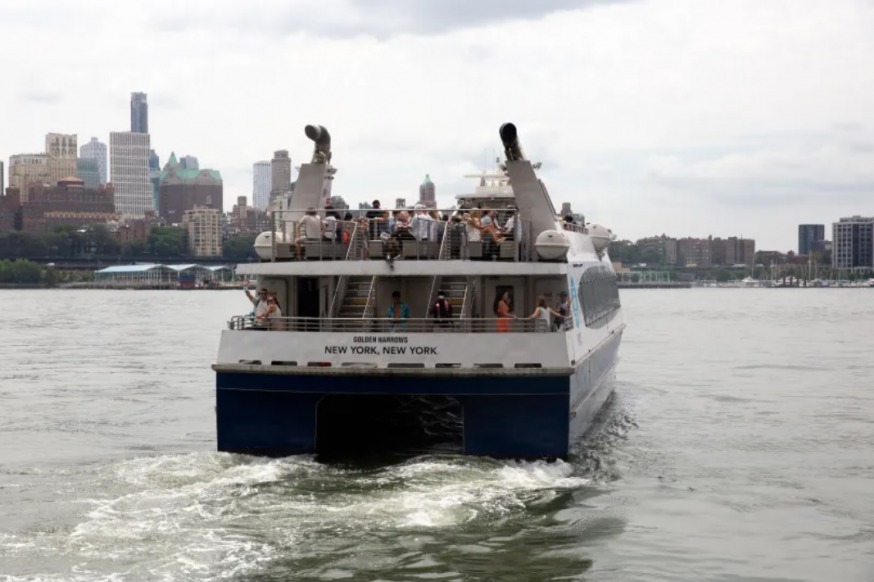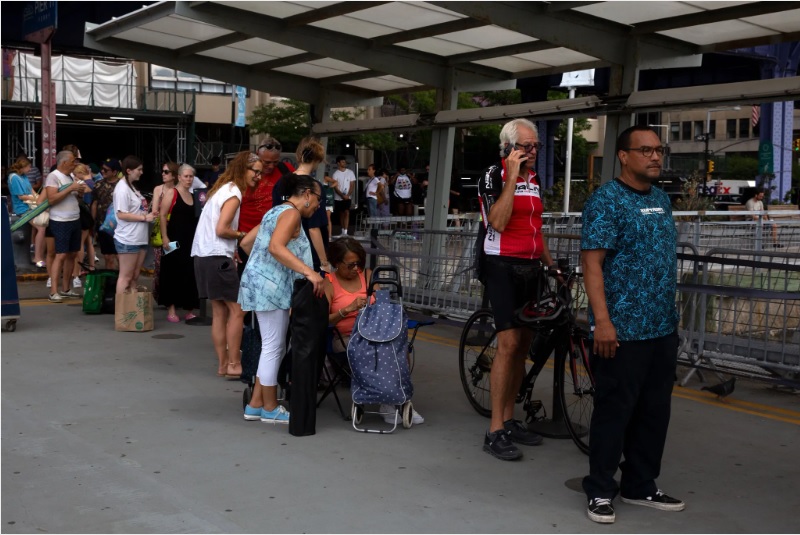
Ben Fractenberg/THE CITY

This article was originally published by The CITY on July 14
The base fare of the New York City Ferry will go up to $4 a ride — with new discounts for seniors and Fair Fare program participants — as the city tries to make its program financially “sustainable,” officials said.
The hike and new pricing structure comes as the city’s Economic Development Corporation had begun pumping more tax-payer money each year into the system, which launched in 2017 under then-Mayor Bill de Blasio.
The tack change also comes a week after Comptroller Brad Lander released an audit — spurred in part on THE CITY’s reporting — that found the system spent almost double the amount it originally said on subsidies to keep it afloat.
Under the new price system, set to launch Sept. 12, the base fare of $2.75 will go up to $4.
New Yorkers over the age of 65, those with disabilities, and participants in the Fair Fares program — which offers half-priced rides within the MTA system for low-income commuters — will get a discounted price of $1.35 per ticket, officials announced.
Public housing residents within a mile of a ferry dock will also get two free boat rides a month.
“Getting around New York City shouldn’t feel like you’re running a 5K. Wherever you live in the five boroughs, we want you to have choices, and our vision for the NYC Ferry helps provide New Yorkers with those choices,” Mayor Eric Adams said at the announcement near the Astoria dock on Thursday.
He said his administration’s “Ferry Forward” plan would be “built on the three pillars of equity, accessibility, and fiscal sustainability.”
The $4 base fare will “offset the cost of everyday New Yorkers who need to take the system,” Adams said.
There will also be discounted 10-pack rides at $27.50 to retain regular commuters who ride the ferry the most.
Low Tide?
Andrew Rein, the president of the independent Citizens Budget Commission, praised the fare adjustment as “welcome progress,” but believes that the base fare should be closer to the $6.75 fare the MTA charges on express bus routes.
“While EDC is employing the right approach, it is starting with lower fares than CBC recommends,” Rein said in a statement.
He added that the city should also consider charging higher fares on weekends and on longer routes with higher operating costs while reassessing the most-subsidized routes.
Rein said the ultimate test will be if the city subsidy per ferry ride — which was $12.88 for Fiscal Year 2021, according to the comptroller’s report — will be reduced.
The mayor argued there is a misconception that only the wealthiest New Yorkers ride the ferry.
“It is for every New Yorker, and the more we introduce New Yorkers to utilizing it, they’re going to see how possible it is to move across this city,” Adams said.

NYC Ferry passengers line up at Pier 11 off Wall Street, July 6, 2022.Ben Fractenberg/THE CITY
“The $4 fare decision was informed by ridership surveys, ridership demand modeling, and past experience with the East River Ferry,” EDC president Andrew Kimball said Thursday.
The EDC’s own data shows the ridership has been predominantly white and higher-income compared to other public transportation.
We’re Going to Need a Bigger Boat
Adams also announced additional express ferry routes to the Rockaway beaches — which was dubbed the “Rockaway Rocket” at the press conference — that will go direct from Pier 11 in Manhattan to the dock at Beach 108th Street starting July 23. Each ride will require a reservation and cost $8 one way.
“What we’ve seen with the Rockaways is extraordinary demand on the weekends to go to the beach,” Kimball told THE CITY. “We are going to add an extra boat, a big boat… so we’re not taking any seats away from anybody as it exists today.”
Last week’s comptroller’s report said the EDC rang up a $758 million bill on ferry-related costs from July 2015 through the end of last year — but only reported $534 million in expenses in its official financial records.
“This is a very substantial financial underreporting and mismanagement,” Lander said while standing near Pier 11 in Lower Manhattan. “$250 million of underreporting raises a lot of questions and those questions should be asked.”
The comptroller’s report followed a series of stories in THE CITY about NYC Ferry, including one in January that revealed how de Blasio’s budget office supplied a $23.2 million infusion for the service before he left City Hall at the end of 2021 — after the service had previously been funded by the EDC.
Lander’s report calls into question the purchase of new boats — something THE CITY flagged in April 2019 — as well as the $2.75 fare that de Blasio insisted on for the privately operated ferry trips. The price of an NYC Ferry trip is still considerably lower than one on similar services in San Francisco and Boston.
THE CITY is an independent, nonprofit news outlet dedicated to hard-hitting reporting that serves the people of New York.
2 Comments

Former Mayor Bill de Blasio assigned the wrong agency to develop his private operator ferry program. NYC EDC had no experience in design and engineering for ferry boats and docks. They also had zero knowledge of ferry operations and management of ferry operator contracts. Contrast that with NYC DOT’s Staten Island Ferry. It manages the nation’s largest municipal ferry system moving 66,000 pre COVID-19 daily riders. The NYCDOT capital ferry program has benefited by over $1 billion in grants from the Federal Transit Administration going back to the 1970’s. NYCEDC has no experience in applying for and managing FTA grants. NYCDOT unlike NYCEDC is also experienced in applying for and administering both capital and operating grants from the State Department of Transportation. Mayor Adams should rectify this mistake and transfer management of the NYCEDC Private Ferry Operators program to NYCDOT.
The US DOT FTA announced a Notice of Funding Availability (NOFA) on July 8th. This is an opportunity to apply for $294.5 million in competitive grant funding. It is now available for the Ferry Grant Programs.
NYC can also apply for capital grants from the NYS DOT to assist in funding. Albany also provides State Transportation Operating Assistance (STOA). Ridership on any transit service generates yearly federal transportation capital assistance via the annual FTA Section 15 annual reporting process.
Mayor Adams needs to convince the MTA Board to support the private ferry program fare structure to also include cross honoring a free transfer to a bus or subway using the old MTA Metro or new One New York (OMNY) Fare Card.
Farebox recovery rates vary based upon the trip, route and time of day. Any rush hour local or express bus, light rail, subway, ferry, commuter rail trip usually carries more riders than mid day, evening, overnight or weekends. Rush hour trips tend to have a better fare box recovery rate and require less subsidy. There is always a fixed cost per hour for any mode of transportation. This includes equipment (bus, subway car, train or ferry purchase) straight line depreciation of equipment over time and mileage, driver, engineer or ferry boat captain’s salary, conductors, ticket takers, deck hands, fuel or power and maintenance of equipment.
(Larry Penner — transportation advocate, historian and writer who previously worked for the Federal Transit Administration Region 2 New York Office. This included the development, review, approval and oversight for billions in capital projects and programs for the MTA, NYC Transit, Long Island and Metro North Rail Roads, MTA Bus, NYC DOT Staten Island Ferry along with 30 other transit agencies in NY & NJ.)
Bring back those ancient Roman ships where everybody has to grab an oar and row to the beat of a large drum in order to go anywhere.
People could commute and burn off a few calories at the same time. It’s environmentally-friendly too as no fossil fuels needed either. Win win all around.